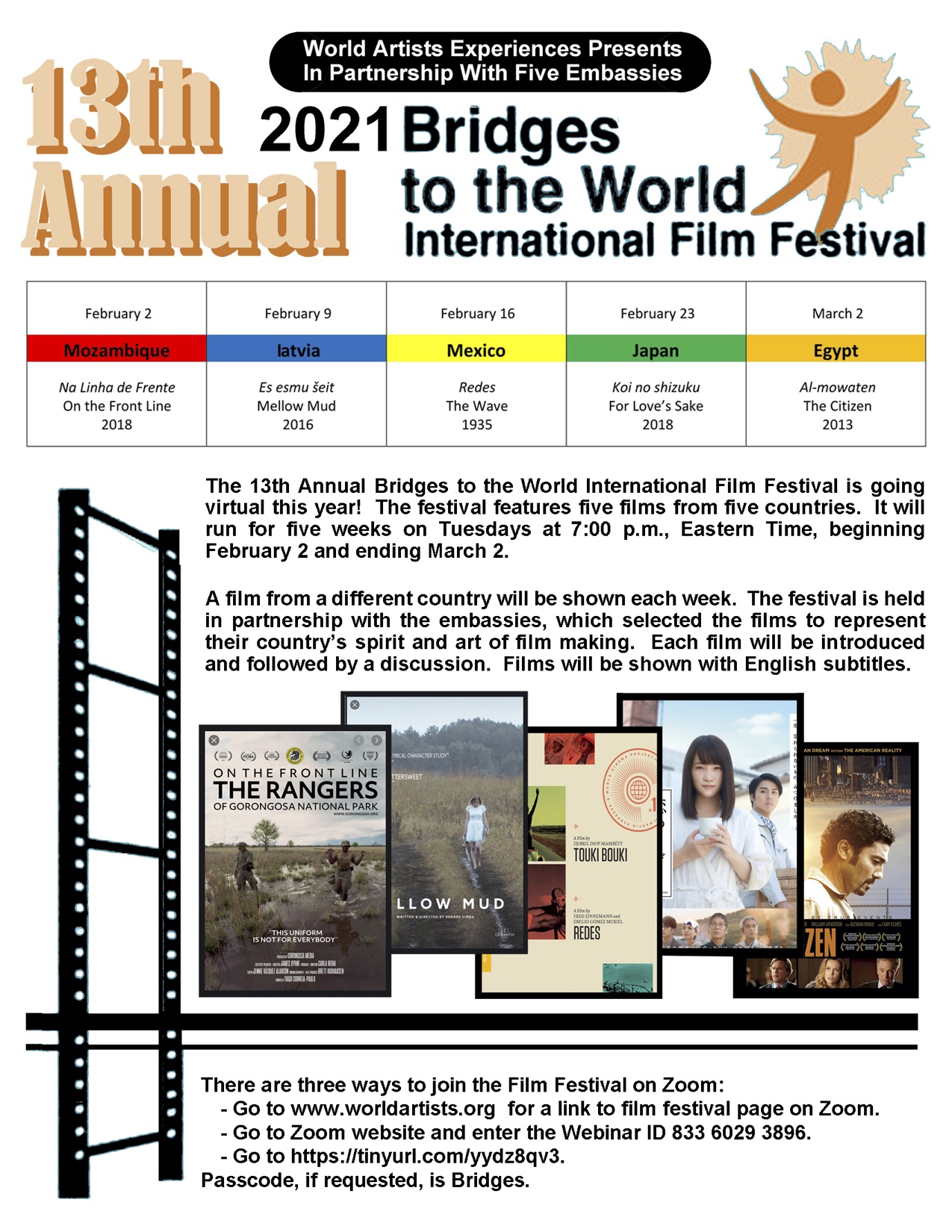Monthly Calendar

In order to attend the 2021 Bridges to the World International Film Festival, attendees will need to follow the Zoom link below and provide a valid name and e-mail address to attend. Zoom Webinars require both a valid name and e-mail address for security purposes.
ZOOM LINK:
https://us02web.zoom.us/j/83360293896?pwd=dCtRbTB3RENBNzBxanA2NFFCV3pRZz09
or
If prompted for a passcode, use the code “Bridges.” WEBINAR ID: 833 6029 3896
PASSCODE: Bridges
February 16, 2021
MEXICO
Redes [The Wave] (1935) Co-Directed by: Emilio Gómez Muriel
and Fred Zinnemann Running Time: 60 minutes
Introduced by:
-
Beatriz E. Nava Domingues,
Deputy Director, Mexican Cultural Institute Embassy of Mexico -
Gregorio Luke,*
Scholar and Lecturer on Mexican ArtIn terms of cinematic and musical history, Redes is a monumental — if perhaps unfamiliar — piece of art. A collaboration between Silvestre Revueltas, Paul Strand, and co-directors Emilio Gómez Muriel and Fred Zinneman, the film proved to be an innovative and seminal work that not only launched Mexico’s golden age of cine- ma (1935–1960), but also created a new form of semi-documentary filmmaking. It demonstrates a clear political and aesthetic link to the Soviet Cinema of the era, particularly the shooting and editing styles of Eisenstein and Pudovkin.
Its use of oppressed people living in poverty, shooting in real locations with natural light, using non-actors, working on a limited budget, and exposing social injustices connects the Soviets to the Neorealist Movement that flourished in the 1940s. In fact, Redes’ story, theme, and filmmak- ing approach are almost identical to Luchino Visconti’s La terra trema (1948), the Italian Neorealist classic about exploited Sicilian fishermen.
Produced by the new Mexican government that emerged after the devastating Mexican Revolution (1910–1920), Redes tells the economic struggle of poor fishermen manip- ulated by the sole owner of their region’s fish market. It celebrates day-to-day physical labor and depicts the working class as intrepid and valiant. Unabashedly pro-union, it champions consciousness-raising and organized resistance as means to achieve social justice and political reform. The film clearly expresses the left-leaning politics in inter- national artistic circles of the time when artists championed the rights of workers everywhere.
Silvestre Revueltas composed Redes’ music, the first of 11 films he scored. He served as the assistant conductor of the National Symphony Orchestra of Mexico (1929–1935) and did much to promote modern Mexican orchestral music. He wrote most of his compositions between 1930 and 1940 when he died due to various health issues at 41. Revueltas’ dazzling score for Redes is emotional, vibrant, colorful, and ultimately heroic. The music elevates the images of the film especially noticeable in three scenes: the sad processional of a funeral, the pulsing excitement of the season’s first successful catch, and the epic drive of an inevitable working-class rebellion. In short, the film’s score is one of the most powerful examples of cinematic music ever written. After Redes, Re- vueltas’ best known work is Sensemayá (1938).
Emilio Gómez Muriel was an up and coming cineaste in the 1930s and eventually became one of Mexico’s most prolific filmmakers, best known for melodramas, into the 1970s.
Fred Zinnemann also began his directorial career in the 1930s and went on to become one of Hollywood’s major directors, helming such films as High Noon (1952), From Here to Eternity (1953), A Man for All Seasons (1966), and Julia (1977), and winning four Academy Awards.
Paul Strand was a major American photographer with strong social realism tendencies. He was also a filmmaker. His best known films include The Plow That Broke the Plains (1936) — sponsored by the US Resettlement Administration — and the anti-fascist Na- tive Land (1942). Both films are clearly influenced by Redes.
Redes runs 60 minutes. The film was restored in 2010 by Martin Scorsese’s World Cinema Project and features a new recording of the original score produced in 2014 at the University of Maryland’s Clarice Smith Performing Arts Center.






